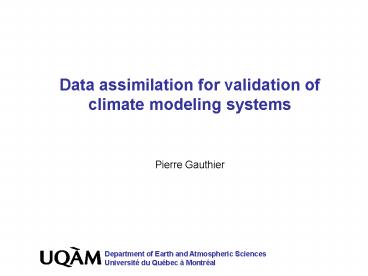Data assimilation for validation of climate modeling systems - PowerPoint PPT Presentation
Title:
Data assimilation for validation of climate modeling systems
Description:
Data assimilation for validation of climate modeling systems Pierre Gauthier Department of Earth and Atmospheric Sciences Universit du Qu bec Montr al – PowerPoint PPT presentation
Number of Views:363
Avg rating:3.0/5.0
Title: Data assimilation for validation of climate modeling systems
1
Data assimilation for validation of climate
modeling systems
- Pierre Gauthier
2
Validation of atmospheric models
- Transpose Atmospheric Model Intercomparison
Experiments (AMIP) - Comparison of atmospheric models against each
other under same conditions (e.g., initial
conditions provided by the same analysis) - Short term forecasts as in NWP
- Intercomparison of data assimilation systems
- More difficult to carry out due to the added
complexity coming from observations, data
assimilation components, and atmospheric model - Impact on both the analysis (information content)
or on the forecasts
3
Schematic of the data assimilation process
(from Rodwell and Palmer, 2007)
4
Validation of atmospheric models against
observations
- Short-term forecast used by the assimilation
- Common ground provided by a short term forecast,
the background state - Sums up the information gained from observations
- Monitoring of averages of observations minus
background is used to detect biases - in new or existing observations
- the model itself (detection of biases)
particularly if the observation dataset has been
carefully quality controlled
5
Monitoring and quality control
- Statistics based on innovations (y -HXb) example
from TOVS radiances
6
Using NWP to assess climate models(Rodwell and
Palmer, 2007)
- Impact of changes to climate models usually done
by comparing several long climate runs with
perturbed models - Uncertainty associated with the physical
processes used in the model (Stainforth et al.,
2005) - Assimilation produces analysis increments to
correct the model forecast to bring it closer to
the observations - Reduced analysis increments is an indication that
the model has improved its fit to observations - Presence of spin-up can be associated with model
differences with respect to what has been
observed - Examination of the physical tendencies in the
early stages of the forecast can provide useful
information about imbalances in the model
7
Schematic of the data assimilation process
(from Rodwell and Palmer, 2007)
8
Time series of precipitation rates averaged over
the Northern Hemisphere (Gauthier and Thépaut,
2001)
9
RMS error w.r.t. unperturbed model vs. Simulated
climate sensitivity
(from Rodwell and Palmer, 2007)
10
Comparing physical tendencies for different
processes in experiments with perturbed physics
Total tendency
Convection
Dynamicalcooling
Rodwell and Palmer (2007)
11
Conclusions
- Data assimilation and reanalyses
- often based on an adapted NWP suite for which the
model short term forecasts have been thoroughly
validated - Using a climate model to do data assimilation
- provide detailed information about systematic
departures from observations - Examination of the physical tendencies associated
with the first instants of a forecast can - Indicate how imbalances in the physical processes
may cause excessive model sensitivity which
increase the uncertainty of climate predictions - Observation datasets used for reanalyses could be
valuable for studies on climate model validation - Added value for the data prepared for reanalyses
12
Conclusion (contd)
- For coupled systems, the complexity is increasing
and this approach is certainly to be encouraged - Parameter estimation with coupled models (Sugiura
et al., 2008) to adjust parameter related to
surface fluxes - Found it was necessary to adjust also other
parameterizations - (1) the wind sensitivity parameter in the ocean
- (2) the isopycnal diffusion coefficient in the
OGCM, - (3) the mixing length in an atmospheric boundary
layer in the AGCM, - (4) the relaxation time for large-scale
condensation in the AGCM, - (5) the range of relative humidity change in the
AGCM, - (6) the standard height for precipitation
efficiency in the AGCM, and - (7) the adjustment time for cumulus convection in
the AGCM































